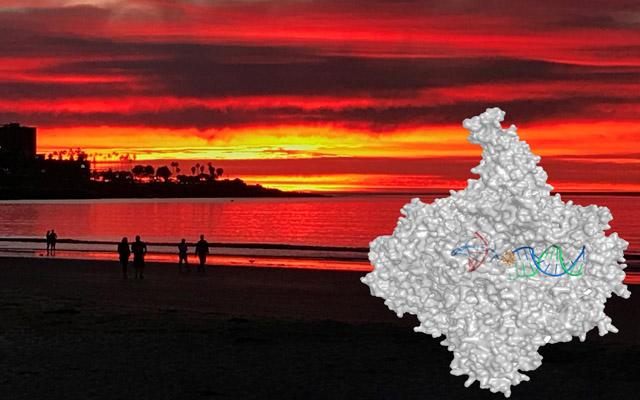Study reveals how enzyme detects ultraviolet light damage

Ultraviolet radiation, such as sunlight, can damage cellular DNA, leading to cancer. UC San Diego researchers have described the underlying mechanism that helps explain why such damage isn't always repaired. Image collage courtesy of Dong Wang, UC San Diego
Called thymine dimers, DNA lesions are damage sites to the base pairs that comprise the structure of DNA. The DNA lesions are caused by exposure to UV light, such as sunlight, which causes neighboring thymine base pairs to bond, disrupting the DNA strand. Untreated, these lesions may eventually result in cancerous growths, such as melanoma.
RNA polymerase I (Pol I) is an enzyme responsible for up to 60 percent of total transcriptional activity in growing cells. It is a key determinant for cell growth control, and is also responsible for identifying lesions and activating repairs at the rDNA region, a DNA sequence that codes for ribosomal RNA.
“It's the most active RNA polymerase in growing cells and so its ability to identify lesions has significant influence on whether a cell can survive UV-caused genetic damage,” said co-corresponding author Dong Wang, PhD, associate professor in the Skaggs School of Pharmacy and Pharmaceutical Sciences and the Department of Cellular and Molecular Medicine at UC San Diego. “However, little is known about how this enzyme actually processes UV-induced lesions.”
In the new study, Wang's lab, in collaboration with Carlos Fenandez-Tornero, PhD, molecular biologist, and colleagues at the Spanish National Research Council in Madrid, combined in vitro enzymatic activity studies with electron cryomicroscopy to characterize the mechanisms that stall Pol I as it approaches a lesion to begin recruiting proteins responsible for DNA repair.
They found that Pol I is able to sense the DNA lesion through specific interactions with both the damaged base and the DNA backbone, stalling right before the lesion reaches the active site of RNA Pol I.
Additionally, the study identified a key amino acid among more than 5,000 that constitute Pol I that is essential to detecting DNA lesions formed by UV damage. Interestingly, this Pol I-specific residue does not exist in other forms RNA polymerases. Mutation studies suggest that this residue is important in controlling the polymerase stall profile at DNA lesions.
Because RNA Pol I is a key determinant for cell growth control, it is also an attractive cancer therapeutic target, said Wang, who suggested the findings could open a new avenue for the development of novel anticancer drugs that target RNA Pol I transcription machinery.
###
Co-authors include: Marta Sanz-Murillo and Maria Moreno-Morcillo, Spanish National Research Council; Jun Xu, UC San Diego; Georgiy A. Belogurov, University of Turku, Finland; Olga Calvo, Spanish National Research Council and University of Salamanca, Spain; and David Gil-Carton, Cooperative Center for Research in Biosciences, Spain.
Media Contact
All latest news from the category: Health and Medicine
This subject area encompasses research and studies in the field of human medicine.
Among the wide-ranging list of topics covered here are anesthesiology, anatomy, surgery, human genetics, hygiene and environmental medicine, internal medicine, neurology, pharmacology, physiology, urology and dental medicine.
Newest articles

Bringing bio-inspired robots to life
Nebraska researcher Eric Markvicka gets NSF CAREER Award to pursue manufacture of novel materials for soft robotics and stretchable electronics. Engineers are increasingly eager to develop robots that mimic the…

Bella moths use poison to attract mates
Scientists are closer to finding out how. Pyrrolizidine alkaloids are as bitter and toxic as they are hard to pronounce. They’re produced by several different types of plants and are…

AI tool creates ‘synthetic’ images of cells
…for enhanced microscopy analysis. Observing individual cells through microscopes can reveal a range of important cell biological phenomena that frequently play a role in human diseases, but the process of…





















